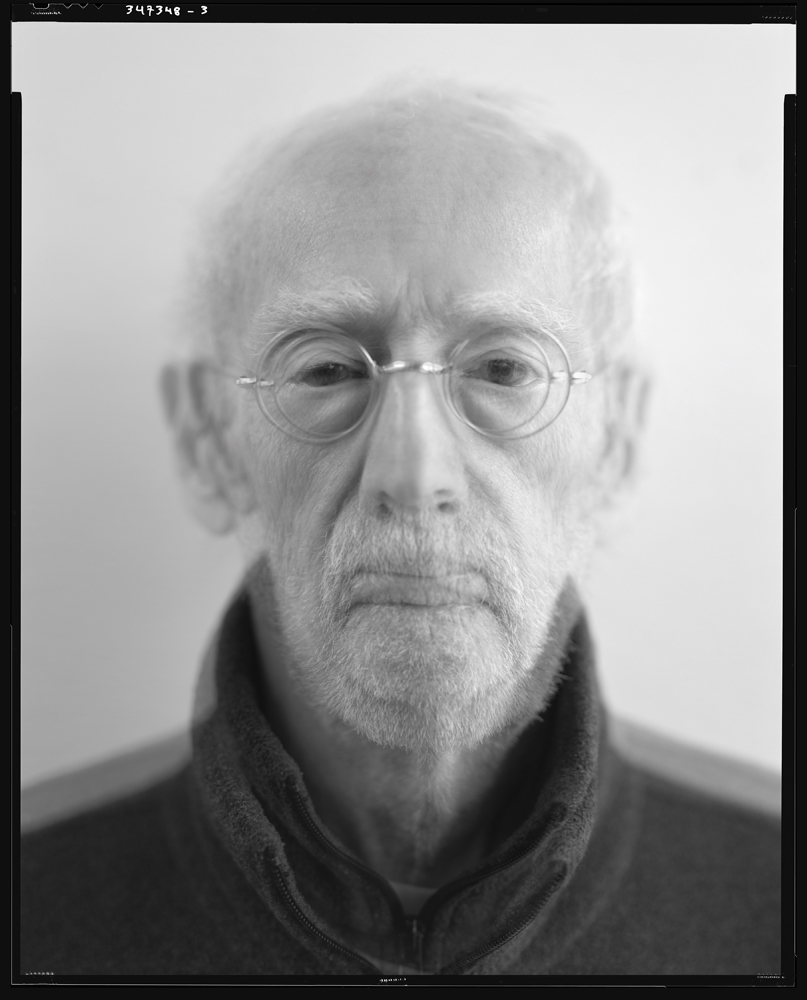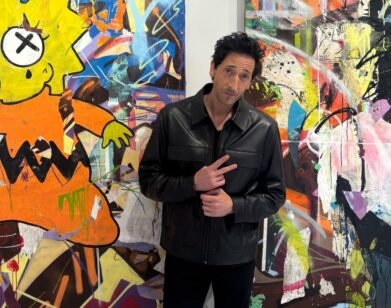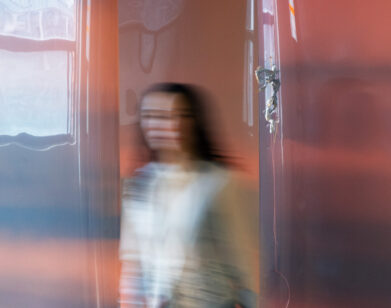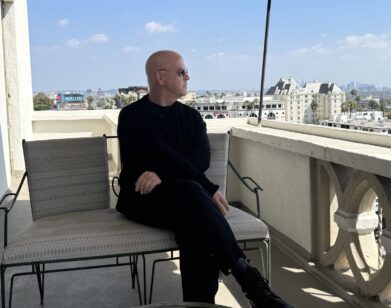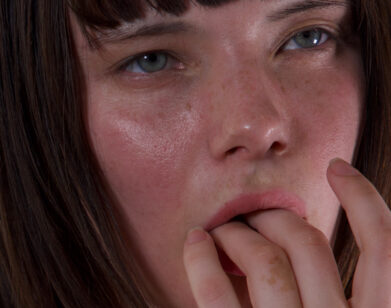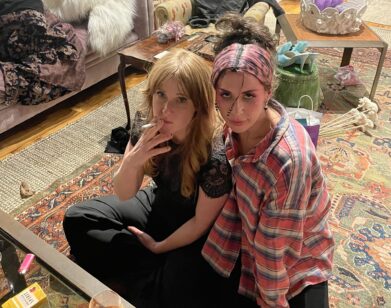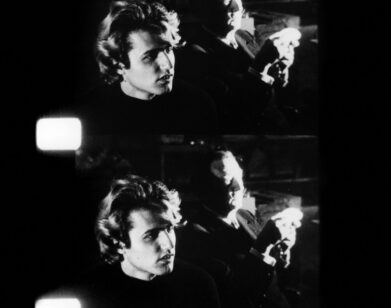Robert Morris
I’VE COME TO REGARD THE ITCH FOR THE BIG AND LOUD REQUIRED BY SPECTACLE AS PUERILE AND CALLOW. Robert MorriS
History—art history in particular—relies on false constructs like decades or movements to make sense of time. There is no such thing as the ’60s any more than there was a single art movement called minimalism—at least not in some contained set of terms with their attendant checklists of leaders and stars. We always seem committed to nailing artists down in such groupings to make sense of them or to get at the heart of what they do. Perhaps no contemporary artist has jittered open those enclosures more continuously and more disturbingly than Robert Morris.
The Kansas City-born Morris did arrive in New York, at age 29, at the beginning of the ’60s, and his polymorphous practices—in material, in form, in duration—defined many of the prevalent styles of the period, from experimental performance works to minimalism, conceptualism, process art, land art, anti-form art—the list goes on. But Morris’s most telling quality might be his agile evasion of a definition. Like his famous sculptural chain-link mazes, his work prompts suggestions of boundaries and confinements as well as fluid, porous holes.
Morris’s early work in New York includes doing choreography with dancers at Judson Dance Theater, and he used his own body in many early sculptural pieces such as Untitled (Box for Standing) (1961), a fir-wood structure that contained or delineated his own form. His experimentation with malleable sculptural materials toyed with or resisted the hard mathematical packaging of many of his “minimalist” peers: cut felt fabric was assembled in dense piles or hung in loose draping from the wall; two tool boxes facing each other were connected by a thick cable chain and painted over in an anemic, industrial gray. There is a clear sense of theater in his productions—viewers became actors or participants in some of his sculptural interventions, as in his series of geometric units such as ramps, beams, tunnels, and weights in his 1971 interactive installation “Bodyspacemotion—things” at London’s Tate Modern. But often the body seems to function as a point of negation instead of as a catalyst: his now iconic 1974 ad for a show at New York’s Castelli-Sonnabend galleries—in which Morris is nude to the waist, wearing an army helmet, and clutching chains—could be read as artist as aggressive male, but it nears the almost homoerotic antithesis of artist as sexual totem. Or maybe it’s artist at war. War has been another visual trope of Morris’s sculptures: felt strips and razor wire, geometric shapes rendered in chain-link. Morris often returns to earlier pieces or materials for further restaging, for open-ended reexaminations in different contexts. Limits in Morris’s art seem like obstacles to overcome rather than to use as the rules of the game—the comforts of a safe instructional structure being a form of containment that doesn’t jibe well with him.
Morris, now 82, works these days in his studios in upstate New York, and is currently preparing for two exhibitions: one of parts of planes and bombs along with felt pieces at Castelli Gallery in January, and another of parts of maple, oak, walnut, and beech at Sonnabend Gallery in February. Artist Wade Guyton, who had been one of Morris’s students at Hunter College in 1996, conducted the following interview via e-mail-Morris’s stipulation—over a course of weeks this past fall.
WADE GUYTON: Last year, I was working on a show for the Whitney, and I went through the museum’s archive to see what had been—and could be—done in that building. I came across several photos of your show from 1970 on the third floor. The show looked awesome and brutal. But also compelling were the images of you installing the show—the artist driving a forklift, smoking a cigar in the space. The first thing that came to mind was what a different time it was in New York and in museums in general. When I did my show, I had to wait for the crew to go to lunch to sneak in and move things around myself. And just this week, I went to another museum where it felt like I was being followed around all day with paperwork to sign to release them from every possible risk in the world and a list of approved tools that I could personally use, including a screwdriver, a tape measure, a pencil, and not much else. So on the one hand, I’m sure the times were different, and the Whitney must have been taking insurance risks with you—and smoking in New York was still possible—but it also seems that you must have been quite aware of how these pictures of you “working” and making “work” would read publicly. Or am I reading those photos from the future, where everyone is so much more aware of their self-representation via social media? Did you stage those photographs?
ROBERT MORRIS: It was the analog age, and I’m still in it. Even today, I don’t have a cellphone and I am not on Facebook. If I am not exactly prehistoric, I remain predigital. Someone told me recently that if something is not on Facebook, it did not happen. Of course, 1970 was a different time, but the bureaucratic constraints may not have been too different 43 years ago. There was opposition to my doing what I did at the Whitney in 1970—from the curator Marcia Tucker, the director, and others who wanted a retrospective, which I thought was ridiculous. Re: photography, I was aware that someone was taking photos while the show was going up, and I found this annoying and distracting. There was a certain amount of physical effort as well as anxiety involved in the installation. I was not certain how the larger installations would turn out, and I was running back and forth. So, no, the photos you saw were not posed. Not that I had not used “posed” photos before—like in I-Box [a 1962 box with a door in the shape of the letter I, which opens to reveal a photo of the artist naked].
GUYTON: If you had told me you were on Facebook, I’m not sure how I would have reacted. Although we are conducting this interview by e-mail.
MORRIS: E-mail for me is just a swift typewriter that lets me avoid the post office, so I don’t regard it as digital, although, of course, it is, in the technical sense, which I suppose is the only defining sense here.
GUYTON: I’m interested in your rejection of the retrospective as a form at that moment. It seems like the works you were making around that time—like Continuous Project Altered Daily [1969]—were also about rejecting a finalized form or the calcification that a retrospective implies. For the artworks at the Whitney—the actual process of moving around large amounts of material—was there an intellectual or ideological alignment with construction work? The artist as worker? Or the converse: a parody of it. As an artist, it’s quite normal to think of oneself as a worker or in the service industry. But for the public or for the institution, that notion must have been unusual in 1970 in New York.
MORRIS: I never identified what I did with construction work, although when I was young, I did some of this. I have made art that required bodily involvement, literally in its production and implicitly in its perception. Still, I never identified with the “workers” who had dirty fingernails and Utopian hopes.
GUYTON: The New York Art Strike Against Racism, War, and Repression [an organization, co-chaired by Morris, which was formed to initiate antiwar actions directed against art institutions] was happening at the same time in 1970. How did your political activity affect the art?
MORRIS: I was involved in the New York Art Strike and protests against the war. Closing my show at the Whitney was part of this.
GUYTON: You closed it? I didn’t know that. How did that happen?
MORRIS: I was in a group show at the Jewish Museum at the same time the Whitney was on. The artists met and voted to close the show at the Jewish Museum in protest over the U.S. bombing of Cambodia. I thought it was only consistent to then close my show at the Whitney. I met with the director, John Bauer, who said the bylaws of the museum did not permit the closing of a floor when the museum itself was open. I told him that in that case I would sit in the doorway. The museum then closed the show.
GUYTON: I like the image of you sitting in the doorway, blocking entrance to your exhibition. And that image must have been threatening, too—enough to change institutional minds to make a public gesture about the war. (It would have been terrible if they broke those bylaws.) The body in the way, the body in the portal, it’s a very primitive action, a protest by being a physical stoppage in the architecture. You’ve repeatedly used your own body in your works. And you had a deep involvement with dance and dancers in the ’60s? How did that come about?
I MADE THE MISTAKE OF THINKING I COULD STAND INSIDE THE COLUMN AND LEAN TO MAKE THE TRANSITION. I SPLIT MY EYEBROW OPEN AND HAD TO GO TO THE EMERGENCY ROOM FOR STITCHES. Robert Morris
MORRIS: I was married to the dancer Simone Forti, so I was involved with dance even before coming to New York in ’60. I choreographed several works, which were presented at the Judson Church in the mid-’60s. And some of those works from that time seemed to involve the body. In the ever-narrowing Passageway [a 50-foot-long plywood passage that narrows as it curves], from 1961, the body is physically constrained as it moves deeper into the curving, ever narrowing space—an early, blatant example.
GUYTON: I remember an anecdote about when you first made Column [1961, a two-foot square gray plywood column] from that same period.
MORRIS: I employed the plywood Column of ’61 in a performance at the Living Theater in the early ’60s, organized by the musician La Monte Young. Column appeared upright on stage for three and a half minutes, fell over, and was horizontal on stage for three and a half minutes-everybody who participated in the evening got seven minutes. In rehearsing in a loft on Chambers Street the morning of the performance, I made the mistake of thinking I could stand inside the column and lean to make the transition. I split my eyebrow open and had to go to the emergency room for stitches. For the performance, I attached a thread and pulled Column over while standing offstage with two black eyes and a bandage around one side of my head.
GUYTON: You’ve put yourself in a box for Box for Standing, a photo of yourself naked inside a cabinet in I-Box, made Passageway and various labyrinths—you even photographed yourself in chains for a Castelli-Sonnabend show in 1974. Part of this is about architecture and the body; movement, lack of movement; being trapped, or even lost. These works conjure an avalanche of metaphors related to human agency or social or political power—whether intentional or not.
MORRIS: Bodies, doorways, political power: If the political involves the application of power—overt or covert—to change people’s behavior, then art is outside this loop, unless perhaps we consider when art crosses over to propaganda. But I would not hazard proposing a criterion for when this happens. Metaphors of power maybe.
GUYTON: One image of you as artist is particularly iconic—the S&M poster. I feel like the story I’ve heard is that it had something to do with Lynda Benglis’s controversial Artforum ad in 1974—that caused the legendary rift in the critical New York art world. Was it related? What role did that poster or you take in that battle?
MORRIS: The ’74 S&M poster was for a double show at Sonnabend and Castelli, when the two galleries were at 420 West Broadway. A group of Blind Time Drawings [a series of drawings made with closed eyes] were upstairs at Sonnabend, and downstairs at Castelli was the sound piece Voice [an eight-track sound installation]. There were no images in the Castelli installation, just some fabric-covered walls to house the speakers and some little benches covered with felt. The angled walls were to break up the low frequencies, and the felt benches absorbed the high frequencies—without these, the empty “live” room would have made the recorded voices difficult to hear. The eight tracks of voices moved around the room and back and forth between the speakers, so controlling sound levels was essential. One of the voice tracks concerned war, another power, another sex, etc. Since the show presented no “images,” I thought I would compress the visual element into the poster. I was trying for a Mars figure, but managed to produce a biker image. Another mistake. Do metaphors have no meanings but rather prompt us to see one thing as another? Did the poster achieve a metaphorical status, demonstrating once again that the artist’s intentions count for nothing? You are asking the questions and I am supposed to be answering, but …
GUYTON: I prefer not to get too deep in the realm of metaphor. It’s more interesting to get back to the material presence (and artist intention!) but hard not to acknowledge metaphors creeping in. I’d say mistaking a biker for Mars (or is it the other way around?) was a great mistake. You didn’t correct it later on, so maybe you don’t regret it so much. Artists’ intentions often seem to be ignored or even negated by the viewer or the context or the critic, but you also seem open to the entropy of interpretation. I’m only guessing that because over the years you have had close relationships or collaborations with writers and other artists. And you’re also known for your own art writing. Are you still writing?
MORRIS: I’ve not stopped. I have, in the past, worked with Jeffrey Weiss [the art writer and Guggenheim curator], and we frequently speak and discuss.
GUYTON: I got the photos of your new works that you sent me, and one thing that is notable is your return to earlier works. In my own work, I will go back to a digital file that is sitting on my desktop and execute it again at different times; the result is a completely different work that changes or becomes present through new physical or contextual pressures. I’m vaguely digital—maybe an analog user of the digital. But your work returns differently. The felt pieces, for example, in the ’60s were considered anti-form or what people call postminimalism—the force of gravity on a material. The colors are gray, brown, and black. They look like default industrial colors. And then the felt works return in the ’80s. House of Vetti [a series of felt works from 1983], for example, looks a little less dependent on gravity, more draped, figurative, or bluntly sexual, and the colors are high ’80s style—pink and gray. I just looked it up on Wiki-pedia. The House of the Vettii is a Pompeii building where, at the entrance, one is greeted with a mural of the Greek god Priapus and his permanent erection protruding from beneath his tunic … So you took a sculptural form of your own that had come to be known in a particular way and allowed it to don new meaning and style. Maybe even contradicting the previous interpretation. The most recent ones, Red Razor I and II, 2013, are red felt and razor wire.
MORRIS: I think I see what you call a “return” more as a continuation or development or drawing out of certain aspects that rise to the surface that I want to explore. And I often work in series with gaps between. The felt works are one example of this. The Blind Time Drawings another. They start in ’73. There are breaks measured in years, then another series exploring another aspect—e.g., using a person blind since birth to execute the works, quoting texts of Donald Davidson and extending the linguistic aspect, switching to Mylar and ink from graphite and paper, etc., etc.
GUYTON: You made Box for Standing first in 1961, and then, some 50 years later, you made Box for Standing 2012. Does the original Box for Standing still exist out there? It was made of fir, and the new one is made of walnut. I noticed the dimensions are slightly different between the two.
MORRIS: The first Box for Standing was made from lumber collected from the street. I originally made the box as a prop for Simone Forti’s performance in ’61. She used it in the horizontal position, crawling under it and making sounds. Afterwards, I had the object in the loft and set it upright, altered the bottom, and it became Box for Standing. But the work got lost or discarded, so I remade it in oak in 1994, then made it once more in walnut. Like many of the larger objects, there were no exact dimensions or definitive materials; the work was different each time these variables were manifested in a version. Of many of these larger works, it can be said that there were no “originals,” just inexact reproductions.
GUYTON: How much time do you actually stand inside of the box?
MORRIS: As long as it took to take the photograph.
GUYTON: Was Box for Standing the first artwork you ever made? It’s the first dated sculpture I can find from you—along with Box With the Sound of Its Own Making [1961; a wooden cube containing a three-and-a-half-hour tape recording of its construction] and Two Columns [1961].
MORRIS: The Box With Sound is dated on the inside as January 9, 1961. Column was made at the same time. Both objects were made in the loft space on Bond Street that I shared with the dancers Simone Forti and Yvonne Rainer. They had the larger space and I had a small room off to the side with a seven-foot ceiling. I had to fabricate Column in the horizontal position and could not set it upright due to the low ceiling. No doubt this limitation suggested the two possible permutations for the work that I later followed up on. Box for Standing was made later, in a loft at 112 Chambers Street. Predating these three works were The Performer Switch [an electrical switch fitted inside a card-file box with directions written inside the lid: “To begin, turn on—continue what you are doing—or don’t—do something else. Later switch may be turned off—after a second, hour, day, year, posthumously”] and The Game Switch [another switch in a box, without instructions, but with a switch with two on positions].
IT CAN BE SAID THAT THERE WERE NO‘ORIGINALS,’ JUST INEXACT REPRODUCTIONS. Robert Morris
GUYTON: When, exactly, did you move to New York from San Francisco? And were you in contact immediately with other artists?
MORRIS: I don’t remember the exact date we moved to New York from San Francisco—must have been late in 1960. I had wanted to move to New York for several years before we did. Forti was working with Anna Halprin and was not enthusiastic to make the move. I didn’t know about the New York “art world” but was aware of the art being made there. I was also fed up with the kind of lifestyle I saw in San Francisco—the sweet apartment with a view, the shiny sports car, weekends in the wine-tasting country, not to mention no winters. When I got to New York, the only artist I knew was La Monte Young—and, of course, Forti, to whom I was still married. I had corresponded with Cage when I was in San Francisco and met him shortly after getting to New York. Johns and Rauschenberg, I met a little later, and Duchamp after that. I probably met Johns at an opening at the Castelli Gallery, although I have no memory of this. I have always held his work in high regard.
GUYTON: I was just walking down Bond Street last night. I can’t imagine what it was like then. I’m wondering if your old studio was swallowed by the Herzog & de Meuron building. What was the rent?
MORRIS: I think the Bond Street loft was one block east of Broadway near Lafayette on the south side, top floor—a nonliving space. I assume the building is still there, but I don’t know this for a fact. Rent was $100 or $200 a month. There were plenty of cheap lofts in SoHo in the ’60s. I had one just below Canal for $85 a month. It got raised to $95, and I was so irate I moved out. Nobody had to work full time to pay the rent, so we had the necessary leisure. Is creativity the “residue of time wasted,” as Einstein once remarked?
GUYTON: Needless to say that the downtown of 50 years ago doesn’t exist anymore. Most young artists have been forced off the island to Brooklyn and Queens, far from where art is sold, in Chelsea, which instead mixes with luxury condos and collectors and their many advisors. But I assume that in SoHo back then the milieu was different: artists, writers, studios, alternative spaces, and galleries in close proximity. What was the atmosphere like and do you think it affected the work being made?
MORRIS: Well, we had time to visit one another—other artists, poets, writers, dancers, et al.—and talk about things. But how specifically these exchanges affected my work is difficult to say. The atmosphere was that we were downtown loft rats and uptown was another world. There were loud loft parties on weekends. Everybody collected at Max’s Kansas City to drink and gossip.
GUYTON: Art history often links you with certain artists like Judd, Flavin, Andre—the “minimalists”—although, to me, your route to making the gray columns, boxes, L-beams, corners, and other objects that look minimal seems different from that group. Did you have any personal relationship with them?
MORRIS: Andre is a genius. I was never close to Judd or Flavin, who were very close to each other. I remember reading somewhere that Judd wrote that, in Morris’s so-called minimal works, “there is not enough to see,” and I suspected that I must be on the right track. Wasn’t minimalism first called “ABC art”? And then “Primary Structures”? Maybe there were other tags, but if so, I’ve forgotten them. Finally, the collective journalistic convention settled on was “minimalism.” Let me quote Carl Andre: “Art is what we do. Culture is what is done to us.”
GUYTON: Since this is an interview for Interview magazine, I feel obligated to ask if you knew Andy Warhol. And what did you think of his work?
MORRIS: I knew Warhol but not especially well. I visited the Factory once or twice and spoke with Andy at social occasions. I thought he was extremely conscious of what he was doing, was able to use those around him in important ways, was relentless and focused in ways opposite to the impression he liked to convey. I was aware of the powerful negativity of his work.
GUYTON: What do you mean by “the powerful negativity”?
MORRIS: Knocking down middle-class notions of painting as art, flaunting the reproductive techniques, mocking “the original,” skewering celebrity, and lauding it at the same time, laying on purposely bad technique, etc. Other pop artists were making similar efforts. But Warhol did it better. He made the point so strongly that repeating it today is a familiar strategy.
GUYTON: You’ve occasionally made paintings throughout your career but you’re not known as a painter. And I recall when I was a student of yours, you were talking about Cezanne a lot. And as you say, you have always held Johns’s work in high esteem. What is your relationship to painting?
MORRIS: I studied painting at the Kansas City Art Institute and started out as a painter in San Francisco.
GUYTON: It sounds like your identification with painting was only in the past.
MORRIS: Oh, well, one can still have nostalgia.
GUYTON: Okay, so going back to something you said earlier—that for your larger works there are no “originals” but inexact reproductions—this must be a tough idea for people who want to put value not just in the touch of your hand but also in age. With your work, does connoisseurship and love of the artist hand still persist?
MORRIS: Many of my drawings show evidence of “the artist’s hand” (e.g., the Blind Time Drawings). And many of the earlier small lead reliefs were obviously handmade. The larger works were different in this respect.
GUYTON: Are you always involved in the making of reproductions? Or do you see some of these works more as instructions that can be carried out by someone else? A score or script?
MORRIS: I am usually involved in the remaking of the large earlier works, but sometimes others draw up the plans or “score” from my instructions. I have purposely left definitive dimensions and surface color of the larger works open to variations, so a certain “indeterminate” aspect belies the definitive “original.”
GUYTON: I remember reading about a reconstruction or reproduction of your works in the Turbine Hall at the Tate recently. I saw images of the Williams Mirrors [a 1977 installation of large mirrors producing endless reflections] somewhere that looked newly fabricated. I’m wondering, are some “inexact reproductions” better than others? Are certain newer contexts for the work better or worse than previous contexts?
MORRIS: I can’t always say when some versions work better than others; some might fit the particular space better, but some crowded installations have worked and so have some spacious ones. You mention the “Bodyspacemotionthings” participatory works reinstalled in 2009 in the Tate’s Turbine Hall. I judged that installation a disaster. The original 1971 installation in the older Tate building was designed with the particularity of the architecture in mind, and the separate “stations” or objects were locked into those spaces. In the later reinstallation, the works were unanchored and flopped around in that grotesquely large space.
GUYTON: A disaster? I just Google-imaged “Body-spacemotionthings” and it doesn’t look so bad online. The space is certainly grotesquely large and more suited to spectacle, but that seems to be the trend in contemporary art spaces. It pushes artists to make larger art just for the sake of spectacle and often there isn’t any skepticism of that expectation.
MORRIS: I detest spectacle.
GUYTON: Would you say that your 1970 Whitney show was anti-spectacle (not that scale necessarily is equated with spectacle)? It looks massive but also calibrated to the building.
MORRIS: I was undoubtedly stirring up spectacle even though the works were “fitted” to the space. In two of the works involving large, heavy elements of concrete blocks and timbers, forces were applied to static arrangements, destabilizing them in ways I could not predict. Chance and gravity then reshaped these two works. Other smaller works involved steel plates making simple configurations.
GUYTON: Based on my unscientific research into the Whitney archive, it looks like that was the largest work or installation shown up to that point and maybe even still to this day.
MORRIS: You are referring to the long work of timbers, blocks, and steel-pipe rollers that stretched across the entire space. I suspect that every artist makes works that, in time, he or she comes to regret. I suppose I was using the large Whitney space as a studio in which to try things I was curious to explore, but had no idea how they would turn out.
GUYTON: Why do you regret it?
MORRIS: I’ve come to regard the itch for the big and loud required by spectacle as puerile and callow, and what the manifestations of spectacle do to the spectator is even more objectionable.
GUYTON: The year before the Whitney show, you did Continuous Project Altered Daily. What do you remember about the conditions of that piece?
MORRIS: The 1969 Continuous Project was done in the Castelli Warehouse uptown. I worked on it mornings; the space was open to viewers in the afternoons. The work was changed every day, photos taken at the end of the morning working session, developed overnight, and posted the next day. This was the routine. For me personally, the experience was wretched and I came to hate the work: tearing apart whatever was made the day before and beginning again.
GUYTON: Did hating the work, in fact, constitute the work?
PERHAPS MY PREOCCUPATION WITH THE SUBJECT MATTER OF WAR IS EXAGGERATED. WHY GET SO WORKED UP? AFTER ALL, KILLING IS WHAT OUR SPECIES SEEMSTO DO BEST. Robert Morris
MORRIS: The work was the work; the process turned into an ordeal. I did not anticipate that working and refusing to come to an end would collapse under me, leaving me at such a loss. It was not a matter of anger and hatred of the work. One can sometimes have admirable intentions and still defeat oneself.
GUYTON: Let’s not dwell too long on the disasters of the past. You sent me photos of two new sculptures from this year, Spats and Fatman. Tell me about these.
MORRIS: Both works involve childhood memories of WWII. Spats is a full-scale model of the landing gear and wheel coverings of the German Junkers Ju 87 B “Stuka” dive bomber. In the ’40s, I, like many other kids, made model airplanes. I had little skill at this and usually never got beyond the stage of gluing together the little sticks of balsa wood. Getting the tissue paper over the cage form and making it tight with the slightly dizzying smell of “dope” applied to the paper—that was beyond me. I thought that the squared-off shape of the plane resembled something Albrecht Dürer might have designed. This was the model of plane Beuys crashed in, but I was not making a memorial to him in revisiting the undercarriage of the plane, only the dive bomber that could approach its target at 90 degrees, the scream from the sirens on the spats announcing the coming mayhem. I left off the sirens in my version. Fatman is a full-scale, openwork rendition of the bomb dropped on Nagasaki. In 1981 I received a small commission from the Navy Department for a sculpture to be put outside a new administration building on the grounds of the fourth largest veteran’s medical center in the U.S., located in Bay Pines, Florida. I researched the kinds of things decorating veteran’s hospitals and found that all kinds of obsolete weapons were put on the grounds—howitzers, tanks, planes, etc. I went to the National Museum of Nuclear Science and History in Albuquerque, New Mexico, claiming to be a journalist writing about the early atomic weapons. I was told that many casings for the two atomic bombs dropped on Japan—the U235 gun—type called Little Boy, and the rounder plutonium one called Fat Man for either Churchill or the film actor Sidney Greenstreet’s character in The Maltese Falcon (both claims have been made)—were held in storage by the Department of Defense. Apparently, the practice test drops of these two bomb casings did not exhaust all of the casings made. I proposed that two of these be requisitioned from the Department of Defense and set on pedestals at 45 degrees outside the building, suggestive of their first moments after leaving the bomb bay, and painted the same beige color of the building. The Navy Department wrote back cancelling my commission and refusing to pay me anything.
GUYTON: I’m not surprised the Navy refused! War and destruction continue to appear in your work—from War the performance [Morris’s first piece at the Judson Dance Theater, in 1963] and bullet trajectory [a lead relief from 1964] in the 1960s to the Firestorm series in the ’80s [a series of drawings, paintings, and reliefs that evoke apocalypse and holocaust] and the Castelli show in 1998 [“Robert MORRIS: The Rationed Years and Other New Work,” which included an installation composed of paintings, school desks, sculptures, and sound pieces relating to Morris’s personal memories of World War II] to name a few. One could say there is an extreme interpretive gulf between, say, a walnut box made for standing in and sculpture of a nuclear bomb—or is there a convergence between these types of artworks?
MORRIS: More than 60 million died in WWII. I was a child in the ’40s—the war news was everywhere and discussed in school. Truman drops the two atomic bombs in ’45, claiming these saved American lives that otherwise would have been sacrificed by invading Japan. I told the Navy Department that if Truman was right, then there had to be men in the Bay Pines VA Healthcare System who owed their lives to these devices. My argument fell on deaf ears. In ’47 Truman establishes the Loyalty Oath, the CIA, and the security state. I was in the Korean War in the early ’50s, another illegitimate U.S. intervention. Just before I got to Korea, a childhood buddy, then a Marine, threw himself on a grenade, for which he was posthumously awarded the Medal of Honor. In ’71, I took part in Vietnam antiwar demonstrations and was once arrested with Noam Chomsky for lying down on the Senate floor in Washington, D.C. In the ’80s, Reagan was supporting the killing in Central America. As the century turns, the U.S., now a full-fledged imperialistic, militarized plutocracy with as many as 900 military bases around the world, invades the Middle East, where Bush & Co. extend the murderous foreign policy with little objection from American citizens. These events have been part of my environment and leaked into my art-making in one way or another, beginning with the performance War in 1963. Perhaps my preoccupation with the subject matter of war is exaggerated. Why get so worked up? After all, killing is what our species seems to do best—the environment, animals, whatever. No other species slaughters their own in uncountable numbers. Everybody knows these things. Why get so exercised by war? I have no answer. Of course, a lot of what I’ve made was not preoccupied by this subject matter. Or is it too much of a stretch to attribute the various disparate themes of my work to a single self? Here I side with David Hume, who wrote that when he looked into what he called himself, he found perceptions of love or hatred, heat or cold, but no self apart from perception.
GUYTON: Your work seems relentlessly experimental and nonterritorial. Materials, strategies, and genres that other artists cling to are picked up, put to use, and put back down by you over the years. You acknowledge the absence of “self” in yourself. Is your work also questioning the territoriality that many artists, writers, institutions, and the market all come to expect and demand?
MORRIS: It strikes me that the idea of an artist and his “territory” is largely a market notion. On the other hand, I would not mind at all if I had a popular “line,” territory, or brand. I just never managed it very well. After all, we live by selling our art to the rich, and they want something that comes with a repeatable narrative, or at least the echoing drone of an encapsulating mantra.
GUYTON: Earlier you mentioned the “negativity” in Warhol’s work. Do you identify negativity in your own work?
MORRIS: Yes, negativity is always hovering. I like W.H. Auden’s quote, “Art is born of humiliation.” And let’s not forget good old hate.
GUYTON: We spoke earlier about the Bond Street studio and its seven-foot ceiling probably having an effect on Column ’61. Your current studio upstate—does it put any pressure on the works you are making now?
MORRIS: I have built two studios. The first is windowless, somewhat dark, grimy, and full of tools, some not touched for decades, abandoned, half formed pieces of corroding metal lean in corners. The largest tool is a massive 1930s Pettingell power hammer bolted to the floor and walls, which is deafening when operating and makes the building shudder. I’ve had it for 30 years and still have not mastered this monster, which is capable of forming such svelte and intricate compound curvatures in metal. Mice live in the building, making nests in any rolls of felt I mistakenly leave in the place. In the summer, when it is hot, blacksnakes that can reach six feet in length lie coiled around the big wooden trusses holding up the roof. The second studio is tall, with two large skylights, much cleaner than the other one. Colonies of bees have lived in the walls for several years. Probably all that honey has an insulating effect. Until this summer, two beautiful copperhead snakes lived in the south wall. These gorgeous creatures would slither out of the wall and sun themselves near the large door on drowsy summer afternoons. In the spring, I often find morel mushrooms at the northeast corner of the building, and in the early fall, the Coprinus, or inky caps, come up on the south side of the building. At first these fungi are virgin white but within a very short time deliquescence transforms them to an inky, slimy black. I am not sure I get the drift of your question about how these studios might put “any pressure on the works” I have recently made.
WADE GUYTON ISA NEWYORK–BASED ARTIST. HE IS REPRESENTED BY PETZEL GALLERY. ALL WORKS © 2013 ROBERT MORRIS/ARTISTS RIGHTS SOCIETY (ARS), NEW YORK.

